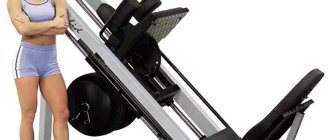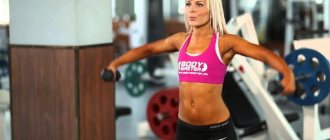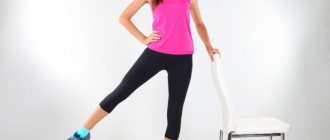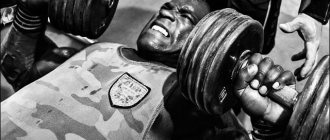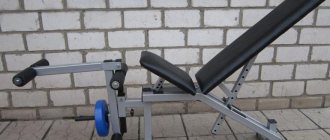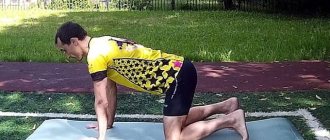The leg press machine allows you to work with amazingly large weights. A striking example of this is the leg press of eight-time Mr. Olympia winner Ronnie Coleman, captured on video. This professional bodybuilder worked with a weight of 1040 kilograms! Of course, the ability to lift such mind-boggling weights is not the main advantage of training on this machine, but it has a lot of advantages, and now we’ll talk about all of it.
The benefits of the leg press exercise in the simulator
The main advantage of the simulator is the removal of stress from the spinal column, but also:
- This simulator removes pressure on the venous network. Compression on the veins is reduced and blood flows out. Therefore, the bench press is an excellent solution for people with varicose veins.
- Another advantage is the ability to instantly fix the platform with a load using rotary levers.
- The ability to emphasize the load on various leg muscles.
- Using a machine to train the calf muscles.
- The machine allows you to train with heavy weights.
- Fixed body position.
Pros of exercise
The most significant is exclusion from the working chain of the spinal column. This gives athletes who have suffered a serious spinal injury a chance to still build muscle. There is no load on the lower back, and no impact on the trapezius as when performing a lift with a barbell. The movement is completely natural and can be performed by any beginner.
How does the toe press affect muscles:
- The calves become denser;
- A relief appears;
- Strength and power-speed characteristics are improved;
- Increases performance in squats due to improved amplitude and stabilization;
- Movement helps prevent tendon injuries
Disadvantages and contraindications of the platform leg press
The simulator does not have any disadvantages as such. If we talk about the benefits and harms of training with free weights, namely the inclusion of spinal stabilizer muscles, then a leg press machine eliminates the development of this type of muscle. On the one hand, this is a minus, so we can consider this a disadvantage for a certain circle of athletes.
But for amateur athletes who train to strengthen their muscles, increase their physical fitness, improve their well-being, as well as people with injuries to the spine and shoulder girdle, a leg press machine will be more relevant.
Like other exercises for developing leg muscles, the leg press machine is contraindicated for athletes with injuries to the ankle, knee and hip joints.
Also, who have troubling leg muscle injuries, such as sprains or bruises, should not perform the exercise It is also important to take into account the fact that when working with heavy weights, a compression load appears on the hip joints and lumbar spine.
Those who have problems with the lumbar region and hip joints should individually limit the working weight to a comfortable one.
What muscles work in the leg press in the simulator?
In the leg press exercise in the simulator, all gluteal muscles and leg muscles are involved, namely:
- Gluteus medius, maximus and minimus.
- Piriformis muscle.
- Superior and inferior gemellus muscles.
- Obturator internus muscle.
- Quadratus femoris muscle.
- Biceps femoris (to a lesser extent).
- Quadriceps femoris (lateral, medial, rectus).
- Adductor muscles of the thigh.
Smith Back Press
The Smith simulator (machine) is more simple in design and is used to train while lying on your back. Essentially it’s just a barbell in a machine, but much safer for training. There is no platform here. The rod moves along the guides. Machine capabilities:
- The leg press in Smith is carried out while lying on your back, and your legs rest against the bar of the barbell - this is the position of the legs in the leg press in this device.
- The exercise can be done with both legs or one (each in turn).
This device allows you to do very deep presses, to the point where the knees are pushed out to the sides when the legs are fully bent - so there is a variety of technique in the Smith.
When doing such deep presses, you need to carefully select the weight of the projectile to avoid injury!
World record leg press
Every strength exercise has its own champions. The leg press is no exception to the generally accepted rules.
Since the simulator is as safe as possible and has virtually no impact on the spine, it is possible to lift very large weights compared to a regular squat with a barbell. Records:
- Pat Robertson claimed to have bench-pressed around 900 kilograms, and his doctor mentioned a weight of 1225 kilograms.
- Ronnie Coleman did it with a machine that weighs 1024 kilograms for eight reps!
There is evidence that there were records with larger weights, but with a smaller amplitude.
Leg position during leg press
Using the simulator, you can specifically train all of these muscles. To do this, you should choose the correct placement of your feet on the platform of the simulator.
- To train the quadriceps (medius and rectus muscles), hamstrings and gluteal muscles of the foot, place them in the center of the platform at shoulder level . This is the basic or classic foot position. By the way, the gluteal muscles are always involved, with any placement of the feet on the platform.
- The next nuance is to shift the feet from the center of the platform to its upper or lower edge. So, when placing the legs close to the upper edge, the athlete transfers the load to the gluteal muscles. The work also includes the hamstrings. Please note that you need to lean on your heel (under no circumstances should you lift your feet off the platform!). Another very important point when working with this position of the feet is to fully press the lower back to the bench. Severing the lower back from the backrest can cause serious injury.
- When placing your feet closer to the bottom of the platform of the simulator, the load is accentuated on the quadriceps femoris muscle. This option is dangerous for the knee joints, so you should not place your feet on the very edge of the platform. By the way, it is impossible to bend your knees completely without lifting your heels, and this is already the wrong technique for performing the exercise.
- Another nuance of the leg press in the simulator is the width of the feet. When doing a narrow leg press , when the feet are practically in contact with each other, the emphasis of the load is on the outer (vastus lateralis) and middle part (rectus). This version of the press, or more precisely, how narrowly the athlete places his feet to each other, depends on his individual characteristics, since with such a position the load on the hip and knee joints increases. To determine a comfortable distance, you should work with minimal weight.
- When doing a wide leg press, the main load will be directed to the adductors, sartorius, gracilis and vastus medialis muscles. When performing such a press, you should turn your feet with your toes apart at an angle of 45 degrees. This increases the load on the adductor surface of the thigh and reduces the load on the knee joints. The knees should also “look” outward. In this case, the bench press should be as deep as possible.
Leg press for girls[edit | edit code]
Leg press for girls
The leg press belongs to the category of basic exercises, since it moves the hip, knee and ankle joints. As a result, not only the quadriceps muscles of the thighs work, but also the back muscles of the thighs, gluteal muscles and calf muscles.
The leg press is considered a safer exercise than the squat because it puts less stress on the lower back (this does not mean that there is no load at all). In addition, the seat of the exercise machine provides good support for the back, which reduces the risk of spinal curvature. Since the trajectory of movement is rigidly set by the simulator, the likelihood of problems with balance is very low.
There are many options for leg press machines that allow you to perform this exercise both sitting and lying down, making it difficult to choose. Therefore, it is better to choose a model that makes you feel most comfortable (that is, feel the least amount of stress on your lower back and knee joints).
Performance
Sit on the seat of the exercise machine, place your feet on the platform, spread them shoulder-width apart. Keeping your back as straight as possible, bend your knees. Don't put your feet too low! Stop when you feel your buttocks begin to lift off the seat. At this point, tighten your thigh muscles and straighten your legs. At the top of the movement, do not straighten your legs completely. After completing the exercise, repeat it again.
Advantage
- Because the movement path is set by the machine and the lower back is sufficiently supported, the bench press is one of the safest exercises for the lower body.
Flaw
- Some bench press machines are poorly designed; But even the best exercise equipment may not suit your body type.
It may seem that the leg press is completely safe for the lower back, but this is not the case. Of course, it is much safer than a squat, but it also puts more stress on your back, especially with a wide range of motion.
Recommendations
- The more you straighten your legs, the more muscle tension is lost. To maintain constant tension, try not to fully straighten your legs at the top of the movement. In this case, it becomes much more difficult to perform the exercise, since the muscles can no longer rest at the top of the movement. You can start the exercise without straightening your legs. If you get tired, straighten your legs for a short time to rest and then perform a few more repetitions.
- The greater the distance between the legs, the more the gluteal muscles and the back group of thigh muscles are involved in the work. A slight tilt of the torso forward gives the same effect.
- By lifting your lower back off the machine seat, you increase the range of motion and, therefore, the load on the gluteal muscles, but you put your back at risk. We do not recommend doing this.
- Attention! As with the squat (page 93), if you have knee hyperextension, do not straighten your legs. Worse, the load can cause your knees to bend further backwards, leading to serious injury.
Options[edit | edit code]
- Varying the platform level. The lower you lower the platform, the more difficult it is to perform the exercise, as an increasing number of muscle groups are involved in the work. However, you should take into account not only the muscles you want to use, but also your body type. The longer your legs (especially your hips), the more dangerous it is for your back and knees to lower the platform too low. An unfavorable torso-to-leg ratio will cause you to have to lift your buttocks off the seat to lower the platform, increasing stress on your spine.
- Varying foot placement. By changing the position of your legs, you can choose which muscles to use. Legs on the top of the platform: gluteal muscles and hamstrings (gentle on the knees).
- Legs on the bottom of the platform: quadriceps muscles (the knee joints bear a large load).
- Feet together: quadriceps.
- Legs apart: hip adductors.
Foot placement options
Types of leg press machines and their features
Although leg press machines are aimed at performing the same exercise, they have some differences.
They are structurally divided into:
- Lever - such exercise machines are also called hummers.
- Sliding ones are the most common options. Typically, the platform moves at an angle of 45 degrees along the guides.
According to the angle of inclination:
- Verticals are a rare beast, but they can still be found in the gym. Such exercise machines place an increased load on the spine. Platform weight may vary. Typically the platform weighs from 27 to 40 kilograms.
- Horizontal - in this machine, the leg press is performed in a horizontal plane. The target muscles for the horizontal leg press remain the same, but the compression load on the lower back, knee and hip joints is noticeably reduced, which makes this exercise option safer. This is most often a block exercise machine or with the ability to add plates of the required weight, so the minimum load is 5 kg.
In principle, all models are effective and work approximately the same. An important difference for an athlete is the angle of movement of the platform and, most importantly, the position of the back.
The more vertical the back is, the less the load on the spinal column.
There is also an option to adjust the tilt angle. The tilt is needed in order to transfer the priority of the load to the quadriceps muscle. However, based on my experience in using the simulator, I can say that this feature does not make a noticeable difference, but the possibility of the feet sliding along the surface of the platform with a large deviation of the back of the simulator greatly increases. Basically, the ability to adjust the inclination of the bench is needed for comfortable work, rather than for transferring the load to the quadriceps.
By the way, the platform is one of the most important elements of the simulator. A lot depends on its coverage. For example, when working on the Interathletics simulator, the shoes do not stand securely on the metal platform. In more expensive versions, the platform is coated with an abrasive compound.
Leg press options
There are three types of simulators for performing this exercise:
- at an angle;
- vertical;
- horizontal.
Angle press
The angled leg press machine is one of the most common machines in all fitness clubs in the world. During execution, the angle between the athlete’s torso and the platform is approximately 45 degrees. This allows you to work in a fairly large amplitude and use serious weight. The other two types of leg press machines have not yet received the widespread distribution they deserve in Russian gyms. It’s a pity, because with their help you can perfectly diversify the load and force the leg muscles to work at new angles, which will lead to even greater progress.
Vertical Leg Press
The beauty of the vertical leg press is that the vector of movement fundamentally changes. The knees do not fall towards the shoulders, but towards the stomach. Because of this, it is easier for us to focus on the work of the quadriceps, especially if we use a narrow parallel stance. It is not recommended to perform leg press variations for the buttocks or hamstrings on a vertical press machine. The slightest technical mistake will result in the tailbone being twisted and lifted upward. This position of the lower back during strength exercises is extremely dangerous.
Horizontal trainer
The horizontal leg press machine is an even rarer beast. But damn interesting and effective. The seat and the bench press platform are in the same plane, there is almost no inclination. This significantly increases the range of motion. Some exercise machines help you add an extra 10-15 centimeters! At first it may turn out that there is no significant difference, but these additional centimeters significantly complicate the task, as new “dead spots” appear. And the working weight immediately becomes less by almost a quarter. The muscles simply begin to tear apart from the strongest pumping.
Leg press technique
The exercise technique is very simple:
- Having taken a comfortable fixed position in the simulator, place your feet on the platform. This will be the starting position.
- Afterwards, remove the weight clamps using the levers (usually located on the sides of the seat).
- The next movement is to lower the weight of the platform by bending your knees. When performing this movement, you should inhale. At the lowest point of the movement, the legs should form a right angle. It is very important not to lift your feet from the platform, and your lower back from the back of the machine.
- Then, from the lowest point of the amplitude, exhaling, push the platform up with your feet (do not straighten your knees completely).
It is very important to adjust the headrest so that it is in line with the back of the machine. If the headrest is tilted back or brought forward (toward the platform), when working with weight, the load on the cervical spine will increase. With such head restraint positions, there is a high risk of neck injury.
Execution technique
- Lie on the back of the machine, press your entire back tightly against it, and grab the handles blocking the limiter with your hands.
- Place your entire feet on the bench press cart, so that your feet are shoulder-width apart or slightly narrower. The big toes look to the sides, the heels look at each other, which gives preferential treatment to the outer quadriceps bundles. When placing the feet in reverse, the effect shifts to the well-known medial bundles, shaped like a drop hanging over the knee.
- Now get ready, remove the platform from the locking supports, and press it up until your legs straighten at the knee joints - this will be the starting position for this exercise.
- Inhale deeply, and gently bending your knees, lower the platform down, but not too deep, not until it touches your chest.
- The optimal angle in the knee joints should be 90 degrees. When the weight drops to the lowest point, tense up and, as you exhale, powerfully press the cart upward using the strength of the muscles of the front surface of the thigh, but be careful not to fully extend your legs in the upper phase, otherwise the load from the muscles will shift to the joints. Do not lift your buttocks off the seat - this may cause lower back injuries! Repeat as many times as you can until complete muscle failure.
It's the LEG PRESS, baby!
Platform leg press with emphasis on the buttocks
To train the gluteal muscles, the exercise technique does not change. The only difference is the placement of the feet, which must be placed as close as possible to the upper edge of the platform. With this exercise, the front of the thigh can touch the chest. That is, the leg press with the feet placed at the upper edge of the platform is performed with greater amplitude. I will repeat once again about the danger of lumbar separation with this version of the exercise.
Smith machine vertical leg press
This exercise replaces the bench press on a vertical machine, but its benefits are questionable .
- Firstly, the exercise is unsafe - there is a possibility of your feet slipping off the bar, which, by the way, is not intended for this.
- Secondly, in the simulator it is impossible to adjust the emphasis on certain muscles by placing your feet, as on a platform, further or closer.
- Thirdly, the exercise can only be performed with an assistant who will remove the barbell from the locks.
How to do it correctly:
- Place the loaded bar at a height that can be reached by your feet.
- Lie on the floor, having previously placed limiters to break the barbell.
- Place the basin under the bar.
- Place your feet slightly wider than your pelvis under the bar.
- Press your lower back firmly into the floor.
- An assistant removes the bar from the locks.
- As you inhale, lower your hips and knees to the sides of your body without twisting your pelvis.
- Exhale and straighten your legs, keeping your knees slightly bent.
Recommendations for men and women
You can include the bench press in your workout either as the first exercise or as number 2 after basic exercises with free weights, it all depends on individual preparation.
- To grow muscle mass, you should select a working weight for 10-12 repetitions and perform 4 sets.
- If the goal is muscle relief and strengthening , especially at the initial stage of training, perform 15-20 repetitions in 3-4 sets.
Which is better – squats or leg presses?
Of course, squats with a barbell work much better and develop the athlete than the leg press, but this exercise is simply irreplaceable for those athletes who have a back injury. Also, the leg press machine will be an excellent addition to training your legs after doing squats. It is important to include this exercise second in training after squats with a barbell. The leg press can be performed with an emphasis on the adductors.
Myths about the leg press
Perhaps we should now not just list all the positive aspects of the leg press, but rather refute the existing negative arguments.
There is no need to maintain balance when performing the movement
Of course, when performing a movement in a machine and squeezing a platform moving in a straight line, unlike squats with a barbell, the athlete does not need to maintain balance in three planes. However, when an athlete is faced with the task of maximizing muscle development, it is precisely thanks to the need to maintain balance that one can activate the muscles to the maximum and work with heavy weights. Thus, to increase muscle growth, the leg press is an excellent exercise.
When stability decreases, the athlete will be forced to reduce the weight of the sports equipment, which will significantly affect a number of factors, for example, muscle adaptation, hormonal response to physical activity, etc.
The leg press is a non-functional movement
Squats are also difficult to call a functional movement; it is only possible when the athlete is faced with the task of improving this movement. A movement can be called functional only if, when performing it, movement occurs in three joints. It is according to these criteria that such a definition is more applicable specifically to the leg press.
The only benefit of the bench press is that it requires more weight.
It must be remembered that in addition to the possibility of using a large working weight, the exercise should be beneficial. Each of the athletes who have performed the leg press at least once agrees that it makes the heart work well.

